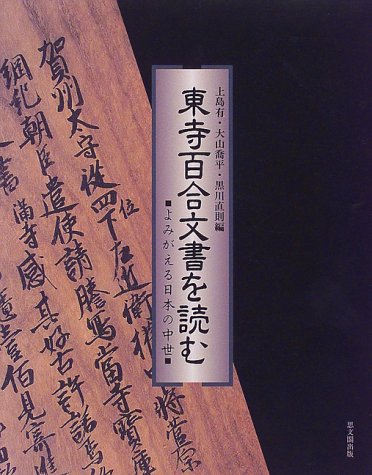3 0 0 0 古文書の様式について
- 著者
- 上島 有
- 出版者
- 公益財団法人史学会
- 雑誌
- 史學雜誌 (ISSN:00182478)
- 巻号頁・発行日
- vol.97, no.11, pp.1829-1868, 1936-1937, 1988-11-20
Many attempts have been made to classify ancient and medieval documents written in Japanese. The method which best reflects the essential nature of the documents is classification according to the document style (様式). In Japan, the following document styles have been generally adopted : (1)Kushikiyo-monjo (公式様文書), (2)Kugeyo-monjo (公家様文書) and (3)Bukeyo-monjo (武家様文書). This method of classification corresponds to the three major political systems from ancient to medieval times, namely, (1)the Ritsuryo state (律令国家), (2)the aristocratic (Ocho) state (王朝国家) and (3)the warrior (Buke) political regime (武家政権). However, if we think of a particular document style as consisting of a common writing style (書式) and overall form, for example, not only do we find many differences between Kansenji (官宣旨) / Senji (宣旨) and Inzen (院宣) / Rinji (綸旨), which have been classified as Kugeyo-monjo (公家様文書), but we also fail to find any common features among these documents. The same is also true of documents classified under Bukeyo-monjo (武家様文書). Therefore, the author proposes that the following classification may be more. suitable : (1)Kushikiyo-monjo (公式様文書), (2)Kudashibumiyo-monjo (下文様文書) and (3)Shosatsuyo-monjo (書札様文書). The author attempts to confirm this point by investigating such aspects of writing style as (1)the sentence structure (文体), (2)the identification of the sender (差出書), (3)the name of the addressee (宛名), (4)the identification of official ranks (位署書) and (5)the method of signing the document (署名の仕方) ; such aspects of form as (6)the calligraphy style (書体), (7)how the paper is ornamented (紙面の飾り方), (8)the choice of paper type (料紙の使い方) and (9)how the sheets are pieced together (紙継目の固定の仕方) ; as well as such procedural practices as (10)the transmission of orders (遵行手続) and (11)rules for drafting the documents (書式作成手続規定). The classification proposed here corresponds to the division of the ancient and medieval state into (1)the Ritsuryo state (律令国家), (2)the early oligarchic (kenmon) state (前期権門国家) and (3)the later oligarchic state (後期権門国家).
2 0 0 0 OA 古文書の様式について
- 著者
- 上島 有
- 出版者
- 公益財団法人 史学会
- 雑誌
- 史学雑誌 (ISSN:00182478)
- 巻号頁・発行日
- vol.97, no.11, pp.1829-1868,1936-, 1988-11-20 (Released:2017-11-29)
Many attempts have been made to classify ancient and medieval documents written in Japanese. The method which best reflects the essential nature of the documents is classification according to the document style (様式). In Japan, the following document styles have been generally adopted : (1)Kushikiyo-monjo (公式様文書), (2)Kugeyo-monjo (公家様文書) and (3)Bukeyo-monjo (武家様文書). This method of classification corresponds to the three major political systems from ancient to medieval times, namely, (1)the Ritsuryo state (律令国家), (2)the aristocratic (Ocho) state (王朝国家) and (3)the warrior (Buke) political regime (武家政権). However, if we think of a particular document style as consisting of a common writing style (書式) and overall form, for example, not only do we find many differences between Kansenji (官宣旨) / Senji (宣旨) and Inzen (院宣) / Rinji (綸旨), which have been classified as Kugeyo-monjo (公家様文書), but we also fail to find any common features among these documents. The same is also true of documents classified under Bukeyo-monjo (武家様文書). Therefore, the author proposes that the following classification may be more. suitable : (1)Kushikiyo-monjo (公式様文書), (2)Kudashibumiyo-monjo (下文様文書) and (3)Shosatsuyo-monjo (書札様文書). The author attempts to confirm this point by investigating such aspects of writing style as (1)the sentence structure (文体), (2)the identification of the sender (差出書), (3)the name of the addressee (宛名), (4)the identification of official ranks (位署書) and (5)the method of signing the document (署名の仕方) ; such aspects of form as (6)the calligraphy style (書体), (7)how the paper is ornamented (紙面の飾り方), (8)the choice of paper type (料紙の使い方) and (9)how the sheets are pieced together (紙継目の固定の仕方) ; as well as such procedural practices as (10)the transmission of orders (遵行手続) and (11)rules for drafting the documents (書式作成手続規定). The classification proposed here corresponds to the division of the ancient and medieval state into (1)the Ritsuryo state (律令国家), (2)the early oligarchic (kenmon) state (前期権門国家) and (3)the later oligarchic state (後期権門国家).
- 著者
- 上島 有
- 出版者
- 京都府立総合資料館
- 雑誌
- 資料館紀要 (ISSN:02884070)
- 巻号頁・発行日
- no.43, pp.3-126,1, 2015
- 著者
- 上島 有
- 出版者
- 日本古文書学会 ; 1968-
- 雑誌
- 古文書研究 (ISSN:03862429)
- 巻号頁・発行日
- no.77, pp.64-79, 2014-06
2 0 0 0 東寺百合文書を読む : よみがえる日本の中世
- 著者
- 上島有 大山喬平 黒川直則編
- 出版者
- 思文閣出版
- 巻号頁・発行日
- 1998
- 著者
- 上島 有
- 出版者
- 京都府立総合資料館
- 雑誌
- 資料館紀要 (ISSN:02884070)
- 巻号頁・発行日
- no.44, pp.1-41, 2016

